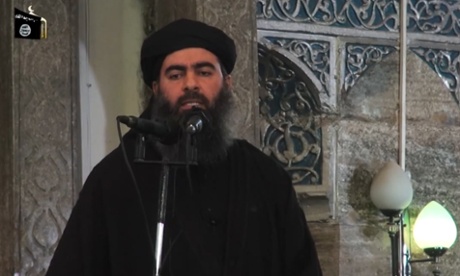PHOTO: Islamic State leader Abu Bakr al-Baghdadi, July 2014
Balsam Aone Mustafa, a Ph.D. candidate at the University of Birmingham, writes for EA and Birmingham Perspectives about the Islamic State’s battle in Syria and Iraq through social media:
Social media has come to the fore during the “Arab Spring” and the revolutions and wars since 2011 in the Middle East and North Africa. However, the Islamic State has taken the medium to a new level with its exploitation of opportunities in the past year.
As it has claimed cities such as Raqqa in Syria and Mosul in Iraq, the Islamic State — previously known as the Islamic State in Iraq and as-Sham, widely known in Arabic as Daesh — has developed its propaganda. It has promoted the “Caliphate”, with its leader Abu Bakr al-Baghdadi making his first appearance on video in a July 2014 address in a Mosul mosque.
But “propaganda” is only a starting term for the Islamic State’s approach to Twitter, YouTube, and many other outlets on the Internet.
This is a strategy of war. The Islamic State wishes to terrify enemies, coerce others, convince their followers, and spreading their narratives and ideologies. The entire Web is a front-line with sites and on-line forums, such as Al-Furqan Media, in which they circulate their news, upload videos, and publish images. They have made use of “independent” sites such as justpaste.it, based in Poland, which allows anyone to publish articles and blogs or upload images and videos. They have exploited lesser-known social networks such as Diaspora and Quitter to evade attempts to block their pages and accounts.
The global nature of the campaign is highlighted by the support of an English translation for each text, photograph, and video through transcription or subtitling. Electronic magazines such as Dabiq are in English and Arabic.
According to reports, the Islamic State has more than 12,000 Twitter accounts for each city under their control, as well as one for each member. Whenever a member account is blocked, they create another one under a fake name. Posting approximately 156 tweets each minute. they use the hashtag as a tool to spread their message. They have even made use of “Twitter bombs” to penetrate the most widely-followed hashtags to tweet and retweet their message, for example, during football’s 2014 World Cup.
This wide-ranging employment of social media supports a two-level strategy of propaganda. On the first level, the Islamic State publicises their atrocities through the videos and photographs of mass executions, beheadings, stoning to death of women, and destructions of holy shrines. These first appear on Twitter before being circulated to YouTube and other social networks and websites. The language used depends on the audience: for example, the video of the beheading of US and British journalists and aid workers features spoken English, aiming at a Western audience.
The second is even more dangerous. The Islamic State uses social media as a platform to seek consent and spread their ideologies and narratives, accompanied with religious justifications for their actions, to convince other men, women, and even children to join them. The videos, often with English subtitling, reconstructs a “reality” which suits the jihadist views and interpretations. Effectively deployed, the campaigns can be more powerful than fighting on the ground.
That is why, part of the solution to defeat Islamic State is the use of the same tools in social media. An effective strategy has to undermine their narratives and dismantle their ideologies and identities by constructing counter-narratives.
Some tentative attempts have been undertaken on both mainstream and social media websites. Iraqi activists, journalists, and ordinary citizens have launched counter-campaigns on Twitter or Facebook to redraw an Islamic State image. For example, a counter-campaign under the hashtag “Baghdad is OK” on Facebook, manipulates rumors by Islamic State members’ accounts that they are approaching Baghdad and are about to capture it.
But this response cannot be the individual efforts of disparate activists, citizen journalists, and bloggers. If the Islamic State is to be confronted, it must be through a collective campaign from governments, institutions, religious and public figures, and ordinary citizens.
The first stage of that campaign is to be honest about the extent of the Islamic State’s own campaign. To defeat your enemy, you have to know him well.

